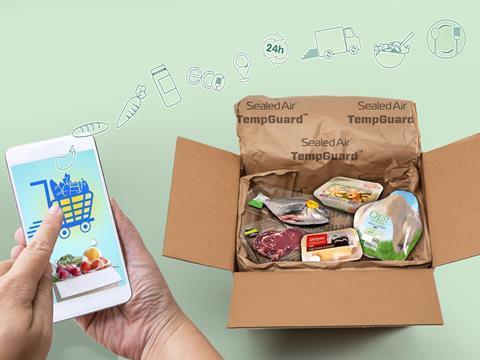
Growing demand for online groceries has heightened shopper expectations and increased the importance of building consumer trust. Andrea Questa, e-grocery solutions manager EMEA at Sealed Air, looks at the critical role of taking a total system approach to primary and secondary food packaging in developing a successful e-commerce strategy.
Taking a fresh look
Strong levels of trust are required among online grocery shoppers to overcome long-standing barriers to purchase fresh foods. A YouGov UK study in 2017 showed that more than half (57%) of non-online shoppers did not trust the quality and freshness of the products they could buy online, while last year, the IGD highlighted how European grocery e-commerce retailers should prioritise the quality of fresh ranges to convince shoppers to buy food online.
This year’s global events are going some way towards changing these shopper attitudes. The pandemic has increased the appeal of buying groceries digitally. Data from PwC’s Global Consumer Insights Survey 2020 shows the majority of European consumers have started to shop for more groceries online, and the desire to shop from the comfort of their own homes means shoppers are more willing to test their concerns about freshness and quality.
However, although consumers crave convenience, this does not mean they are prepared to make compromises in other areas such as food quality and freshness. In fact, it’s quite the opposite, and as demand for online shopping grows, so do customer expectations. Recent analysis by Retail Economics epitomises this, with the consultancy’s CEO pinpointing the impact of the pandemic on how people shop and stating: “consumer behaviour is evolving at a frightening pace and the single largest challenge for retailers is to meet, if not exceed, customers' expectations.”
A total system approach to food packaging can help e-food businesses satisfy growing market demands. The right combination of high-performance primary and secondary packaging will protect food quality and integrity, and maintain the correct temperature inside the package, whether that’s hot or cold. Furthermore, taking a more holistic view of the packaging will also help improve sustainability.
Together, this comprehensive and aligned packaging system ensures shoppers receive food in a safe, highly appealing, and edible condition, while also reducing environmental impact. This helps strengthen consumer trust and brand loyalty and the likelihood of shoppers to recommend products and e-commerce food retailers to other consumers.
Thinking about primary and secondary packaging in unison
Although both primary and secondary packaging must work together to achieve the overall aim of maintaining food quality and safety during storage, handling, and transit, they must also deliver in other crucial areas. They should maximise sustainability and reduce waste, improve the unpackaging experience for consumers, communicate information and brand stories, and optimise available transportation space so more food is shipped per square metre.
Achieving success in each of these areas can be even more complex when selling fresh and frozen foods such as meat and fish, and hot meals. The secondary part of the packaging system will then need to also deliver insulation protection.
While this helps maintain temperatures to safeguard food against spoilage, it can impede other packaging system performance characteristics. For example, large and bulky insulation materials or boxes can quickly reduce cube optimisation, meaning it becomes more expensive and carbon-intensive for processors and retailers to transport food.
There’s also the consideration that some packaging insulation materials are non-recyclable or difficult to recycle. This doesn’t bode well with consumers, who are increasingly focused on sustainability. The PwC Global Insights Survey shows 43% of consumers internationally expect businesses to be accountable for their environmental impact.
Packaging influence
Kantar Retail research for Sealed Air shows that 76% of shoppers say packaging positively affects their perception of retailers, whilst 70% are unlikely to buy again from the same company after a poor shipping experience. These factors are likely to gain more influence as grocery e-commerce markets continue to grow and become more competitive.
Increased competition tends to provide consumers with greater choice and purchasing power. In these market conditions, shoppers won’t settle for anything less than perfect and will see no reason to compromise on any of their varying requirements, whether that’s food quality, safety, convenience, sustainability, or brand experience. A total packaging solution where primary and secondary packaging work in unison to satisfy customer expectations will build consumer trust, loyalty, and repeat sales.
















